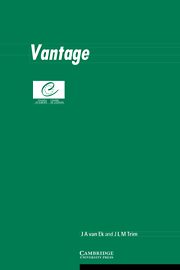Book contents
- Frontmatter
- Contents
- Introduction
- 1 The objective: levels of specificity
- 2 The objective: general characterisation
- 3 The objective: extended characterisation
- 4 The objective: components of the specification
- 5 Language functions
- 6 General notions
- 7 Topic-related tasks and lexicon
- 8 Discourse structure and verbal exchange
- 9 Dealing with texts: reading and listening
- 10 Writing
- 11 Sociocultural competence
- 12 Compensation strategies
- 13 Learning to learn
- 14 Degree of skill
- 15 By-products
- APPENDICES
13 - Learning to learn
Published online by Cambridge University Press: 28 January 2010
- Frontmatter
- Contents
- Introduction
- 1 The objective: levels of specificity
- 2 The objective: general characterisation
- 3 The objective: extended characterisation
- 4 The objective: components of the specification
- 5 Language functions
- 6 General notions
- 7 Topic-related tasks and lexicon
- 8 Discourse structure and verbal exchange
- 9 Dealing with texts: reading and listening
- 10 Writing
- 11 Sociocultural competence
- 12 Compensation strategies
- 13 Learning to learn
- 14 Degree of skill
- 15 By-products
- APPENDICES
Summary
Vantage is an objective derived from the estimated needs of the learners as communicators. A course – that is the sum total of the learning experiences offered to the learners – designed for Vantage will have to enable the learners to satisfy these needs. Yet, it will inevitably do other things as well. Depending on its design and presentation it may give the learners pleasure or hardship, it may promote, maintain, or reduce their motivation for learning, it may bolster or diminish their self-confidence, it may stimulate their interest and sensitivity to the world around them or it may cause them to withdraw into themselves. In short, it may benefit the learners far beyond the basic objectives of the course or it may limit itself to these and, possibly, it may even harm the learners as individuals. All these effects – positive or negative – are independent of the learning load that is represented by the content of an objective; they are produced by the impact upon particular learners of the forms and the manners of the presentation and the practice of this content. At the same time they may affect the learners' impression of the learning load in making this load appear to be more demanding or less so.
The experience, then, of learning for Vantage will affect the learners in various ways beyond the acquisition of a certain learning content.
- Type
- Chapter
- Information
- Vantage , pp. 110 - 114Publisher: Cambridge University PressPrint publication year: 2000



